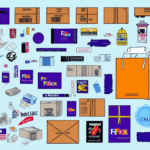Understanding FedEx Hazmat Shipping Rates
Hazmat shipping, also known as hazardous material shipping, involves the transportation of dangerous goods that can potentially harm people, the environment, and property. This type of shipping demands meticulous attention and is regulated by stringent federal, state, and international laws. FedEx, one of the world's largest courier companies, plays a pivotal role in hazmat shipping. In this article, we will delve into what hazmat shipping entails, the significance of hazmat shipping regulations, various types of hazmat materials, factors influencing hazmat shipping rates, and more. By the end of this read, you'll gain a comprehensive understanding of FedEx hazmat shipping rates and the best practices for shipping dangerous goods.
What is Hazardous Material (Hazmat) Shipping?
Hazardous material shipping refers to the transportation of materials that are potentially harmful or dangerous. These materials encompass a wide range of products, including chemicals, gases, explosives, flammable liquids, and radioactive materials. They can pose a threat to public health and safety, the environment, and property if not handled and transported properly.
There are strict regulations and guidelines in place for the transportation of hazardous materials. These regulations are enforced by government agencies such as the Department of Transportation (DOT) and the Environmental Protection Agency (EPA). The regulations cover everything from packaging and labeling requirements to the training and certification of personnel involved in the transportation process.
It is imperative for companies that transport hazardous materials to have a thorough understanding of these regulations and to ensure compliance. Failure to comply can result in fines, legal action, and damage to the company's reputation. Additionally, proper handling and transportation of hazardous materials can help prevent accidents and protect the public and the environment from harm.
The Importance of Hazmat Shipping Regulations
The importance of hazmat shipping regulations cannot be overstated. These regulations ensure the safety of individuals, the environment, and property during the transportation of hazardous materials. The Department of Transportation (DOT) and the International Air Transport Association (IATA) are responsible for regulating the transportation of hazardous materials in the United States and internationally, respectively. These organizations have established strict guidelines and requirements that must be adhered to when shipping hazardous materials.
One of the primary reasons why hazmat shipping regulations are crucial is the potential threat hazardous materials pose to human health and the environment. Improper handling and transportation can lead to fires, explosions, and other dangerous incidents resulting in injury or death. Moreover, hazardous materials can cause long-term environmental damage, such as contaminating soil and water sources.
Furthermore, hazmat shipping regulations help prevent accidents and incidents by requiring shippers to follow stringent guidelines and procedures. These regulations ensure that hazardous materials are packaged, labeled, and transported safely and securely, protecting individuals, the environment, and property from potential harm.
FedEx's Role in Hazmat Shipping
FedEx is a leading courier company globally and plays a critical role in hazmat shipping. The company offers specialized shipping services for hazardous materials, including dangerous chemicals, explosives, and other hazardous products. FedEx employs a team of trained personnel who are well-versed in the regulatory requirements for shipping hazardous materials, ensuring all packages comply with applicable regulations.
In addition to specialized shipping services, FedEx provides hazmat training programs for its employees and customers. These programs offer comprehensive training on the safe handling, packaging, and transportation of hazardous materials. FedEx's hazmat training programs are designed to equip individuals involved in hazmat shipping with the necessary knowledge and skills to handle hazardous materials safely and responsibly.
Different Types of Hazmat Materials and Their Classifications
Hazmat materials are classified based on the nature of the hazard they present, with nine distinct classes:
- Class 1: Explosives
- Class 2: Gases
- Class 3: Flammable liquids
- Class 4: Flammable solids
- Class 5: Oxidizers
- Class 6: Toxic materials
- Class 7: Radioactive materials
- Class 8: Corrosive materials
- Class 9: Miscellaneous hazardous materials
Each class has specific labeling, packaging, and handling requirements that must be followed when shipping hazardous materials. Additionally, hazmat materials can be further categorized into subcategories. For example, Class 3 flammable liquids are divided based on their flashpoints:
- Class 3A: Flashpoint below -18°C
- Class 3B: Flashpoint between -18°C and 23°C
- Class 3C: Flashpoint between 23°C and 61°C
Beyond the nine classes, special provisions apply to certain types of hazmat materials, such as lithium batteries, infectious substances, and airbag inflators. These provisions introduce additional requirements for the safe transportation of these materials, complementing the standard hazmat class regulations.
Factors Considered in Determining Hazmat Shipping Rates
Hazmat shipping rates are influenced by several factors, including:
- Type of hazardous material: Different materials have varying levels of risk and regulatory requirements.
- Weight and volume: Heavier and bulkier packages typically incur higher rates.
- Mode of transportation: Air, ground, and sea transport have different cost structures.
- Distance: Longer distances generally result in higher shipping rates.
- Level of service: Expedited services or additional handling requirements can increase costs.
Hazmat shipping rates are typically higher than regular shipping rates due to the special handling and regulatory compliance involved. FedEx hazmat shipping rates are competitive and vary based on the aforementioned factors.
Another consideration affecting hazmat shipping rates is the packaging used. Packaging must meet specific regulatory requirements to ensure the safe transportation of materials. Non-compliant packaging can lead to additional fees for repackaging to meet the necessary standards.
The destination of the hazardous material also impacts shipping rates. Different countries have varying regulations and requirements for hazmat transportation, which can result in higher shipping costs. It's essential to research and understand the destination country's regulations before shipping hazardous materials.
How to Properly Package Hazmat Materials for Shipment
Proper packaging is critical for the safe transportation of hazardous materials. Hazmat packages must comply with specific requirements for labeling, marking, and documentation. The packaging must be robust enough to prevent leakage or damage during transit. FedEx provides detailed guidelines for packaging hazardous materials, and adhering to these guidelines is essential for regulatory compliance.
Different hazardous materials necessitate different packaging types. For example:
- Liquids: Must be packaged in leak-proof containers to prevent spills.
- Solids: May require cushioning to avoid damage during handling and transit.
- Gases: Require secure containment to prevent leaks or ruptures.
Additionally, some hazardous materials may require special permits or approvals before shipment. It's crucial to research and understand the specific packaging requirements for each type of hazardous material to ensure legal compliance and safety during transportation.
Understanding the Hazmat Documentation Process
Hazmat documentation is a vital component of the hazmat shipping process. Essential documents include:
- Material Safety Data Sheet (MSDS): Provides detailed information about the hazardous material, including its properties, health effects, and safety precautions.
- Shipping Paper: Contains information about the package contents, handling instructions, and emergency response procedures.
- Hazmat Labels: Indicate the type of hazard and necessary safety measures, affixed to the package.
Documentation requirements vary by mode of transportation. For example, air transportation mandates stricter documentation standards than ground transportation. International shipments require additional documents, such as a Shipper's Declaration for Dangerous Goods. Ensuring compliance with all relevant hazmat documentation regulations is crucial for the safe and legal transport of hazardous materials.
Tips for Complying with Hazmat Shipping Regulations and Avoiding Penalties
To comply with hazmat shipping regulations and avoid penalties, businesses should:
- Properly classify hazardous materials: Accurately determine the class and category of each material.
- Ensure proper labeling and marking: Use the correct labels and markings as per regulatory guidelines.
- Follow packaging and handling procedures: Adhere to specified packaging standards to ensure safety.
- Provide adequate training: Train employees involved in hazmat shipping on safety and compliance protocols.
- Maintain accurate records: Keep detailed and current records of all hazmat shipments.
Compliance with hazmat shipping regulations not only helps avoid penalties but also ensures the safety of employees, customers, and the environment. Hazmat materials pose significant health and safety risks if mishandled, making adherence to all regulations and guidelines imperative.
Additionally, businesses should regularly review and update their hazmat shipping procedures to stay current with any regulatory changes. Collaborating with reputable carriers and suppliers experienced in handling hazmat materials can provide valuable guidance and support throughout the shipping process.
Common Hazmat Shipping Mistakes to Avoid
When shipping hazardous materials, avoiding common mistakes is essential for compliance and safety. Some frequent errors include:
- Incorrect classification: Misclassifying the hazardous material can lead to improper handling and increased risk.
- Using improper packaging: Non-compliant packaging increases the likelihood of accidents and regulatory penalties.
- Failing to label or document correctly: Inadequate labeling and documentation can result in shipment delays and fines.
- Lack of employee training: Untrained employees may mishandle hazardous materials, leading to safety hazards.
- Shipping without necessary permits: Transporting hazardous materials without proper permits violates regulations and can incur significant penalties.
Navigating the Hazmat Shipping Industry: Tips and Best Practices from Experts
The hazmat shipping industry can be intricate, but following expert tips and best practices can streamline the process:
- Stay Updated: Keep abreast of the latest regulations and guidelines to ensure compliance.
- Partner with Experienced Carriers: Work with reputable carriers like FedEx who specialize in hazmat shipping.
- Provide Detailed Information: Accurately describe the contents of the package to ensure proper handling.
- Adhere to Packaging and Labeling Standards: Always use appropriate packaging and labeling procedures to maintain safety and compliance.
The Future of FedEx Hazmat Shipping Rates: What to Expect
The future of FedEx hazmat shipping rates is anticipated to be shaped by several factors, including evolving regulatory requirements, increasing competition from other shipping companies, and advancements in technology. As the demand for hazmat shipping services continues to rise, FedEx and other carriers will need to adapt by offering innovative solutions tailored to customer needs.
Technological advancements, such as enhanced tracking systems and improved packaging materials, are likely to influence hazmat shipping rates by increasing efficiency and reducing costs. Additionally, changes in global trade and environmental policies may impact the regulatory landscape, subsequently affecting shipping rates.
In conclusion, FedEx hazmat shipping rates are a crucial consideration for businesses that transport hazardous materials. Understanding the regulations, proper packaging and labeling, and compliance with hazmat shipping requirements are essential to avoid penalties and ensure the safety of all parties involved. By following the tips and best practices outlined in this article, you can navigate the hazmat shipping industry with confidence, ensuring the safe and efficient transport of hazardous materials.






















